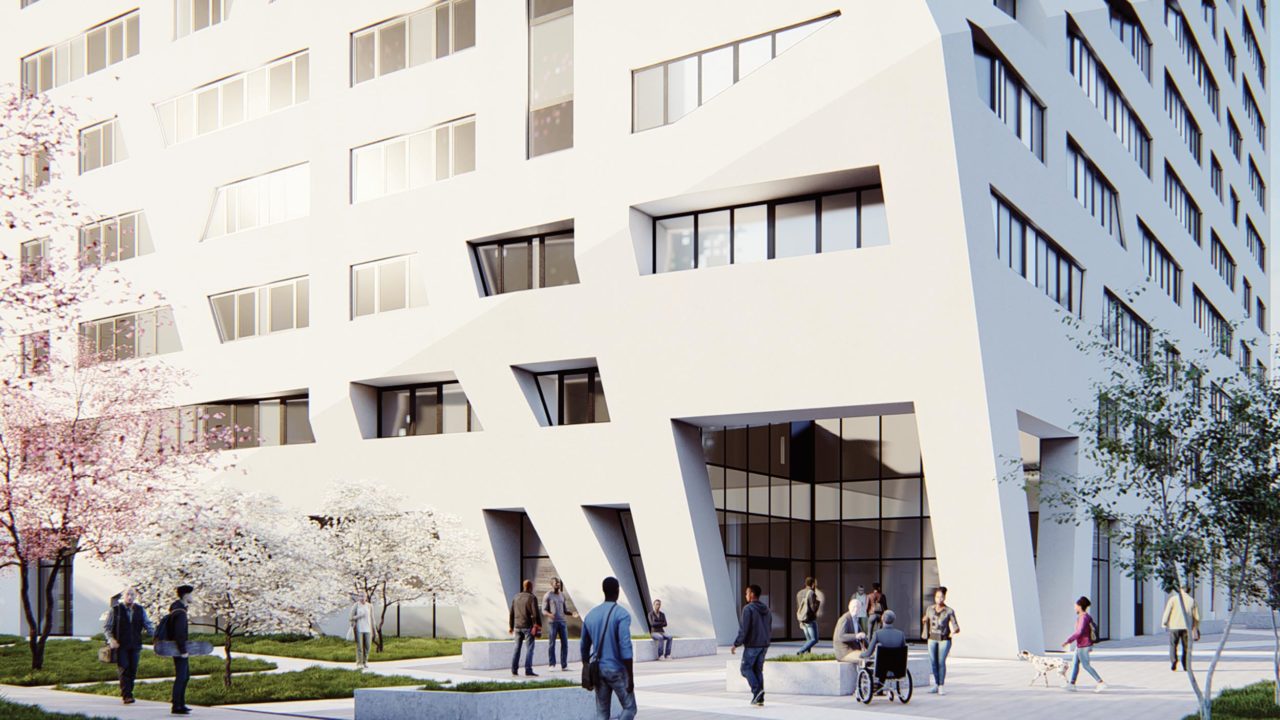

What started as an effort to develop much-needed senior housing on underutilized parcels of land at various NYC Housing Authority (NYCHA) campuses has quickly become a showcase for some of the most innovative and ambitious designs in affordable housing—not just in New York City, but arguably anywhere in the country. In 2019, after highly competitive RFPs for their Seniors First Program, NYCHA announced two projects that perhaps best demonstrate how the housing authority hopes future iterations will lead the way: the Atrium and Casa Celina.
In total, the Atrium (at Sumner Houses), designed by Studio Libeskind in the Bedford-Stuyvesant neighborhood in Brooklyn, and Casa Celina (at Sotomayor Houses), designed by Magnusson Architecture & Planning in the Soundview neighborhood of the Bronx, will generate nearly 400 affordable apartments for seniors. But the hope of both design teams is that the impact of these two buildings will be far greater than units alone. “Our goal with the design of the Atrium was to create a sense of community—designing meaningful spaces for living for both the individual and the collective,” said partner-in-charge, Carla Swickerath. “The final result will be a building that creates a sense of civic pride, one that welcomes the neighbor-hood and provides much-needed housing and resources for seniors in Bed-Stuy.”
Visually, the angular and irregular geometries of both buildings can be seen in direct contrast to the regimented punched windows and rectilinear façades of the NYCHA buildings surrounding them. This is an evolution of the public housing typology: at once consistent with the freestanding towers that often characterize these properties, and the street rhythms that such a plan creates; and wholly new in their reimagining of both the resident experience and the relationships of these structures to the adjoining neighborhoods. There is a notable vibrancy to each of these buildings, and not just because of their light façade coloring, but also in the way their ground floors allow for a certain transparency and connection to the community. Centrally located on their respective campuses, the Atrium and Casa Celina house a broad range of programs and activities, which draw older adults from the surrounding neighborhood into the building, creating a sense of place, community, and porosity where stark boundaries had previously existed.
From its inception, the Seniors First Program recognized the importance that NYCHA residents place on the older members of their communities, and challenged teams responding to each RFP to bring new focus and spatial articulation to the needs of this population. “From program space that encourages socialization to sustainability features that improve the health and wellness of its residents, Casa Celina will radiate a positive social impact in the neighborhood,” comments Fernando Villa, a principal with Magnusson Architecture & Planning. “This is a great example of how we can elevate the design of affordable senior housing and reframe public housing to focus on dignity and quality of life.”

Since the inception of Seniors First over five years ago, nearly a dozen projects are now in various stages, from RFP to fully occupied, many of which push the envelope on housing design in exciting directions. This includes the subtle minimalism of COOKFOX’s recently completed Betances Residence, and the cascading sawtooth façade of the award-winning Sol on Park (at the Morris Houses), also designed by Magnusson Architecture & Planning. While not every project has been as adventurous as the Atrium or Casa Celina, many of these projects are also raising the bar on sustainability and resilience and, consequently, raising expectations industry-wide for what is achievable in newly constructed affordable housing.
Part of what has made NYCHA’s Senior First so successful is the intelligent way the program layers subsidies and incentives from various city agencies, including Affordable Independent Residences for Seniors boosts from the Zoning Resolution, financial resources from Housing Preservation and Development and Housing Development Corporation, and land identified as being underutilized by NYCHA. With a senior population rising faster than any other segment in the city, the biggest critiques of the program might be “more” and “faster,” but ultimately it is a strong example of the forward-thinking designs and innovative communities that can be achieved when city agencies, local residents, stakeholders, architects, and developers work together to address an urgent and growing need.
Brian Loughlin, AIA, APA, (“Street Level”) is Director of Planning and Urban Design, Magnusson Architecture and Planning; Co-Chair, AIANY Housing Committee, Division Chair, APA Housing & Community Development; Adjunct Associate Professor of Architecture and Real Estate Development, Columbia GSAPP.















